Pair of coronal mass ejections on Sun to cause geomagnetic storming on Earth on 25, 26 April
A stream of high-energy particles resulting from a pair of solar flares will graze past Earth between 25 and 26 April, even though the associated coronal mass ejections are not directly aimed at our planet.

- Active Region 3638 on the Sun has erupted in a pair of M-class solar flares.
- These flares are associated with coronal mass ejections, which carry a portion of the Sun’s magnetic field outward.
- While the CMEs are not directly aimed at Earth, the stream of high-energy particles is expected to brush past our planet between 25 and 26 April.
New Delhi: The cluster of sunspots designated as Active Region (AR) 3638 has erupted in a pair of M-class solar flares, each of which was associated with a coronal mass ejection (CME). The pair of CMEs are not aimed straight at the Earth, but the stream of high energy particles streaming out of the Sun is expected to brush past the planet between 25 and 26 April.
Solar flares are intense outbursts from the Sun, with coronal mass ejections carrying a portion of the Sun’s magnetic field outwards. When this magnetic field interacts with the geomagnetic field of the Earth, it can cause disturbances that can last for days or weeks, as well as spectacular polar lights. The arrival of the twin CMEs between 24 and 25 April is expected to cause geomagnetic disturbances.
The Space Weather Prediction Centre (SWPC) of the US National Oceanic and Atmospheric Administration (NOAA) has forecasted disturbances to the geomagnetic field of the Earth between 23 and 24 April, with the chances of minor storming on 25 April.
How are solar flares measured
After a period of quiescence, solar activity reached high levels with five low level M-class flares. The largest of these flares was measured M2.8 on the scale. Solar flares are measured on a scale that increases in intensity through the letters B, C, M and X. Each of the letters are accompanied by a finer-grained scale that goes from 0 to 9. There is no upper limit to the numbers accompanying the strongest category of flares.
Two minutes of radio disturbance
The SWPC also issued an alert for two minutes of radio disturbances on 23 April, 2024, in association with a solar flare. Such events introduce radio noise for short durations, potentially causing interference in sensitive radio receivers used in radar, GPS and satellite communications.












![Haldi decoration ideas at home: Simple and stunning haldi decor [Photos] Haldi decoration ideas at home: Simple and stunning haldi decor [Photos]](https://images.news9live.com/wp-content/uploads/2024/05/simple-haldi-decoration-at-home.png?w=400)
![Saree style for summer: Learn from Ankita Lokhande [PICS] Saree style for summer: Learn from Ankita Lokhande [PICS]](https://images.news9live.com/wp-content/uploads/2024/04/Ankita-Lokhande-saree-6.jpg?w=400)


![Stylish cotton saree blouse designs for 2024 [Pics] Stylish cotton saree blouse designs for 2024 [Pics]](https://images.news9live.com/wp-content/uploads/2024/04/Untitled-design-2024-04-20T081359.168.jpg?w=400)